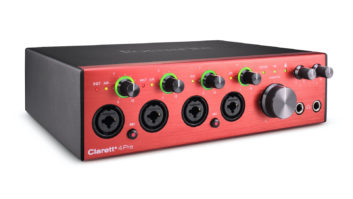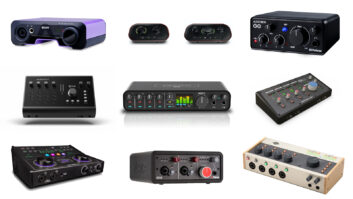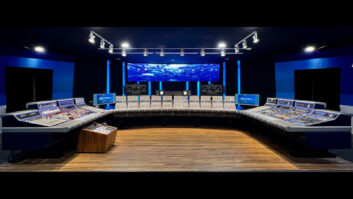Focusrite has extended its reach into the DAW I/O market with a 4×10, 24-bit/192kHz interface featuring dual-classic Focusrite preamp paths, hardware-side DSP and plug-in technology borrowed from its Liquid Channel and Forte Suite TDM lines. Also included is advanced software and monitoring control — all for $499.
GETTING LOOKS
Attractive in silver and stark-white, Saffire stands vertically on a base that can be pivoted to provide extra lateral stability for Saffire’s 7-inch-tall stature. The simple front panel layout offers two analog input paths, switchable between the phantom-powered XLR and ¼-inch instrument/line jacks that are located at the bottom of the panel. A pair of input gain pots (+13dB to + 60dB mic/instrument; -10dB to +36dB line) and three LED level meters are located near the top. In the middle are S/PDIF and MIDI signal indicators, a MIDI Thru switch, main monitor level control with mute and dim switches, and dual ¼-inch headphone outputs with independent volume controls.
Saffire’s featherweight plastic fascia construction and cheap-feeling buttons and knobs initially threw me, but it’s probably better that corners were cut here rather than in the electronics. However, I was quite disconcerted that there is no phantom-power “on” indicator — ribbon mic users beware!
The back panel sports eight ¼-inch balanced line outputs intended (and suitably labeled) for stereo-pairs operation and 5.1/7.1 formats. Coaxial S/PDIF I/O, MIDI I/O (capable of acting as a 1×1 MIDI interface) and dual FireWire 400 ports round out the unit’s connectivity. Capable of being powered by the FireWire bus (6-pin cable included), a 12-foot line-lump power supply is provided for computers that have only a 4-pin FireWire connection or that cannot supply enough power on their own.
PRECIOUS CONTROL
The dual-platform installation disc contains ASIO drivers for Win XP (Mac OS X provides plug-and-play via Core Audio), SaffireControl software and the accompanying plug-ins that are essential for tapping into the DSP-based effects. These are “hard-wired” to SaffireControl and can only process inputs and outputs, not individual tracks. The plug-ins are also provided in VST/Audio Units format so that you can freely use them for mixing within your DAW under host power. A free copy of Steinberg Cubase LE is also bundled to sweeten the deal.
More than an “audio panel” offered with other interfaces, SaffireControl is an elegant “mix surface” providing access to advanced hardware input processing, sequencer output busing and individual processing/mixing of all stereo outputs (monitor and headphone paths). On their way in, signals can be treated by Saffire’s compressor, EQ and amp simulator, with foldback reverb available on the monitor paths.
What’s fantastic is that all monitor routing and reverb levels are software matrix — controlled, not hard-wired, so you can easily create blends between DAW output buses and live inputs for each performer, all with zero latency and zero impact on your CPU. The software can be set to whatever level of complexity is required by the session, and a handy Float button keeps the control window in clear view at all times on a cluttered screen.
PUT TO THE TEST
Saffire sounds amazing. I’ve heard stand-alone mono channel strips that cost three times as much and aren’t as musically pleasing as the dual inputs here. The plug-ins, though simple, are top-notch in quality; I especially enjoyed the opto-compressor and natural room reverb, which sounds distinctly analog and favorably treated a wide range of program material with smooth responses with no noticeable artifacts. The rather vanilla-sounding 4-band EQ, though extremely good, won’t offer any boutique coloration you may be after. Similarly, the amp models (generic British, American, combo and bass) probably won’t replace the tones of your favorite plug-in rig, but are versatile nonetheless.
With five separate stereo outs with DSP-based plug-ins on them, latency-free monitoring is child’s play. From SaffireControl, I was able to create a surround monitoring mix and dual stereo headphone mixes using subgroups from my sequencer in a matter of seconds. This allowed me to send two performers different mixes simultaneously, blending each with varying degrees of hardware monitor ‘verb on their input paths during tracking. And because I could set SaffireControl to float over my DAW, I was able to tweak effects and adjust interface parameters on the fly and without missing a beat. A neat feature of the front panel monitor knob is that it acts on all outputs, not just 1 through 2, making it a master fader in surround mode. Cool.
The FireWire latency was impressively low at 4 ms in 44.1k operation, making Saffire an excellent choice for live, virtual instrument — based performances when tag-teamed with a laptop. Being a Tascam GigaStudio user, though, I missed not having GSIF driver support.
A REAL GEM
Saffire represents a marked turning point for compact audio interfaces. The first device in its class to deliver ultra-low latency, 192kHz HD audio, onboard DSP with integrated plug-ins and sophisticated monitor mixes with zero-latency reverb puts it head and shoulders above the competition. The transparent preamps and stellar converters are the kind of attention to sonic detail you’d expect from Focusrite.
Focusrite, 866/FOCUSRITE, www.focusrite.com.
Jason Scott Alexander is a producer/mixer/remixer in Ottawa, Ontario.







